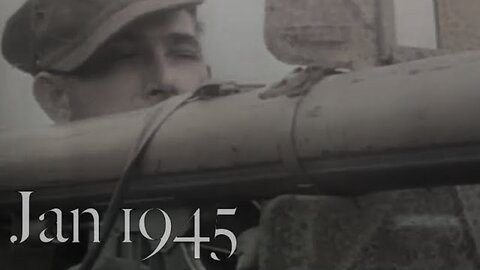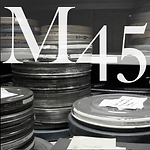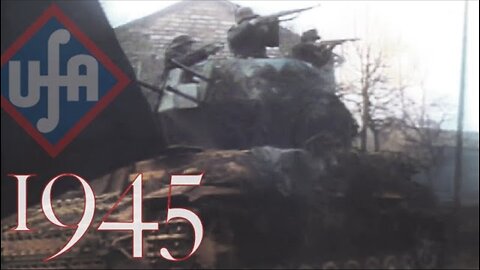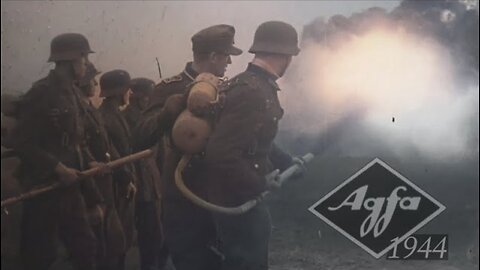
-
Leaving Warsaw (FLAME THROWING T-34 in pursuit) Ausland-Tonwoche Nr 700 Jan. 1945
 Military1945🔥PREVIEW ALL YOUTUBE VIDEOS www.Patreon.com/Military1945 Episode 244 ORIGINALS for sale... https://www.militaria1945.com Ausland-Tonwoche Nr. 700, Jan. 1945 1:24 - Germany: ROA (Russian Liberation Army) at an Orthodox Church service 2:05 - General Vlasov and other senior ROA officers give Christmas gifts to children 3:04 - Flemish fascist boarding school for girls 4:02 - Berlin: Underground bunkers, which house a public kitchen, library, reception hall mayor, printing, hairdressing salon. 5:59 - Western Front: Use of charge boats against a bridge 6:49 - Volkssturm recruits receive their uniforms and weapons 6:10 - Volkssturm recruits being trained to use anti-tank weapons 7:38 - Poland: Military operations, near the river Veyhsel, Warsaw and Breslau Before the end of December ominous reports were received by Guderian—who, in this desperately late period of the war, had been made chief of the German general staff. German Army intelligence reported that 225 Soviet infantry divisions and 22 armored corps had been identified on the front between the Baltic and the Carpathians, assembled to attack. But when Guderian presented the report of these massive Soviet offensive preparations, Hitler refused to believe it, exclaiming: “It’s the biggest imposture since Genghis Khan! Who is responsible for producing all this rubbish?” If Hitler had been willing to stop the Ardennes counteroffensive in the west, troops could have been transferred to the Eastern Front; but he refused to do so. At the same time he refused Guderian’s renewed request that the 30 German divisions now isolated in Courland (on the Baltic seacoast in Lithuania) should be evacuated by sea and brought back to reinforce the gateways into Germany. As a consequence, Guderian was left with a mobile reserve of only 12 armored divisions to back up the 50 weak infantry divisions stretched out over the 700 miles of the main front. The Soviet offensive opened on January 12, 1945, when Konev’s armies were launched against the German front in southern Poland, starting from their bridgehead over the Vistula River near Sandomierz. After it had pierced the German defense and produced a flanking menace to the central sector, Zhukov’s armies in the centre of the front bounded forward from their bridgeheads nearer Warsaw. That same day, January 14, Rokossovsky’s armies also joined in the offensive, striking from the Narew River north of Warsaw and breaking through the defenses covering this flank approach to East Prussia. The breach in the German front was now 200 miles wide. On January 17, 1945, Warsaw was captured by Zhukov, after it had been surrounded; and on January 19 his armoured spearheads drove into Łódź. That same day Konev’s spearheads reached the Silesian frontier of prewar Germany. Thus, at the end of the first week the offensive had been carried 100 miles deep and was 400 miles wide—far too wide to be filled by such scanty reinforcements as were belatedly provided.34 views
Military1945🔥PREVIEW ALL YOUTUBE VIDEOS www.Patreon.com/Military1945 Episode 244 ORIGINALS for sale... https://www.militaria1945.com Ausland-Tonwoche Nr. 700, Jan. 1945 1:24 - Germany: ROA (Russian Liberation Army) at an Orthodox Church service 2:05 - General Vlasov and other senior ROA officers give Christmas gifts to children 3:04 - Flemish fascist boarding school for girls 4:02 - Berlin: Underground bunkers, which house a public kitchen, library, reception hall mayor, printing, hairdressing salon. 5:59 - Western Front: Use of charge boats against a bridge 6:49 - Volkssturm recruits receive their uniforms and weapons 6:10 - Volkssturm recruits being trained to use anti-tank weapons 7:38 - Poland: Military operations, near the river Veyhsel, Warsaw and Breslau Before the end of December ominous reports were received by Guderian—who, in this desperately late period of the war, had been made chief of the German general staff. German Army intelligence reported that 225 Soviet infantry divisions and 22 armored corps had been identified on the front between the Baltic and the Carpathians, assembled to attack. But when Guderian presented the report of these massive Soviet offensive preparations, Hitler refused to believe it, exclaiming: “It’s the biggest imposture since Genghis Khan! Who is responsible for producing all this rubbish?” If Hitler had been willing to stop the Ardennes counteroffensive in the west, troops could have been transferred to the Eastern Front; but he refused to do so. At the same time he refused Guderian’s renewed request that the 30 German divisions now isolated in Courland (on the Baltic seacoast in Lithuania) should be evacuated by sea and brought back to reinforce the gateways into Germany. As a consequence, Guderian was left with a mobile reserve of only 12 armored divisions to back up the 50 weak infantry divisions stretched out over the 700 miles of the main front. The Soviet offensive opened on January 12, 1945, when Konev’s armies were launched against the German front in southern Poland, starting from their bridgehead over the Vistula River near Sandomierz. After it had pierced the German defense and produced a flanking menace to the central sector, Zhukov’s armies in the centre of the front bounded forward from their bridgeheads nearer Warsaw. That same day, January 14, Rokossovsky’s armies also joined in the offensive, striking from the Narew River north of Warsaw and breaking through the defenses covering this flank approach to East Prussia. The breach in the German front was now 200 miles wide. On January 17, 1945, Warsaw was captured by Zhukov, after it had been surrounded; and on January 19 his armoured spearheads drove into Łódź. That same day Konev’s spearheads reached the Silesian frontier of prewar Germany. Thus, at the end of the first week the offensive had been carried 100 miles deep and was 400 miles wide—far too wide to be filled by such scanty reinforcements as were belatedly provided.34 views -
German Newsreel ATW 697 1945 Sepp Dietrich's 6th Panzer Army + US POWs paraded through streets RAW
 Military1945🔥PREVIEW ALL YOUTUBE VIDEOS www.Patreon.com/Military1945 Episode 265 Be sure to give this video a THUMBS UP! Best way to support the channel! SUBSCRIBE to M1945 AUSLAND-TONWOCHE Nr. 697 01.1945 01:21 - Members of the Hitler Youth celebrate the Winter solstice 01:57 - Training of German Mountain Troops 02:45 - Germany: Christmas celebration for orphans 04:30 - Ante Pavelic inspects Coratian soldiers 05:15 - Combat operations on the Eastern Front 06:34 - Ardennes Offensive (Battle of the Bulge) combat footage 13:43 - BONUS: 1944 Allied POs paraded through the streets of Paris After World War II in Europe began, Dietrich led the Leibstandarte during the German advance into Poland and later the Netherlands. After the Dutch surrender, the Leibstandarte moved south to France on 24 May 1940. They took up a position 15 miles southwest of Dunkirk along the line of the Aa Canal, facing the Allied defensive line near Watten. That night the OKW ordered the advance to halt, with the British Expeditionary Force trapped. The Leibstandarte paused for the night. However, on the following day, in defiance of Hitler's orders, Dietrich ordered his III Battalion to cross the canal and take the heights beyond, where British artillery observers were putting the regiment at risk. They assaulted the heights and drove the observers off. Instead of being censured for his act of defiance, Dietrich was awarded the Knight's Cross of the Iron Cross. During this campaign members of the Leibstandarte 2nd Battalion were responsible for the murder of 80 British and French POWs, in what became known as the Wormhoudt massacre Dietrich remained in command of the Leibstandarte throughout the campaigns in Greece and Yugoslavia before being promoted to command of the 1st SS Panzer Corps, attached to Army Group Center, on the Eastern Front. In 1943, he was sent to Italy to recover Benito Mussolini's mistress Clara Petacci. He received numerous German military medals. Dietrich commanded the 1st SS Panzer Corps in the Battle of Normandy. He rose to command 5th Panzer Army during the later stages of this campaign. Hitler gave him command of the newly created 6th Panzer Army. Dietrich led it in the Battle of the Bulge (December 1944-January 1945). He had been assigned to that task because, due to the 20 July Plot, Hitler distrusted Wehrmacht officers. On 17 December, Kampfgruppe Peiper—an SS unit under his overall command—murdered 84 U.S. prisoners of war near Malmedy, Belgium, in what is known as the Malmedy massacre. In March 1945 Dietrich's 6th Panzer Army and the LSSAH spearheaded Operation Spring Awakening, an offensive in Hungary near Lake Balaton aimed at securing the last oil reserves still available to Germany. Despite early gains, the offensive was too ambitious in scope and failed.[18] After that failure, the 6th SS Panzer Army (and LSSAH) retreated to the Vienna area. As a mark of disgrace, the Waffen-SS units involved in the battle were ordered by Hitler to remove their treasured cuff titles bearing his name. Dietrich did not relay the order to his troops.[18] Shortly thereafter, Dietrich's troops were forced to retreat from Vienna by Soviet Red Army forces.[20] Dietrich, accompanied by his wife, surrendered on 9 May 1945 to the U.S. 36th Infantry Division in Austria.89 views
Military1945🔥PREVIEW ALL YOUTUBE VIDEOS www.Patreon.com/Military1945 Episode 265 Be sure to give this video a THUMBS UP! Best way to support the channel! SUBSCRIBE to M1945 AUSLAND-TONWOCHE Nr. 697 01.1945 01:21 - Members of the Hitler Youth celebrate the Winter solstice 01:57 - Training of German Mountain Troops 02:45 - Germany: Christmas celebration for orphans 04:30 - Ante Pavelic inspects Coratian soldiers 05:15 - Combat operations on the Eastern Front 06:34 - Ardennes Offensive (Battle of the Bulge) combat footage 13:43 - BONUS: 1944 Allied POs paraded through the streets of Paris After World War II in Europe began, Dietrich led the Leibstandarte during the German advance into Poland and later the Netherlands. After the Dutch surrender, the Leibstandarte moved south to France on 24 May 1940. They took up a position 15 miles southwest of Dunkirk along the line of the Aa Canal, facing the Allied defensive line near Watten. That night the OKW ordered the advance to halt, with the British Expeditionary Force trapped. The Leibstandarte paused for the night. However, on the following day, in defiance of Hitler's orders, Dietrich ordered his III Battalion to cross the canal and take the heights beyond, where British artillery observers were putting the regiment at risk. They assaulted the heights and drove the observers off. Instead of being censured for his act of defiance, Dietrich was awarded the Knight's Cross of the Iron Cross. During this campaign members of the Leibstandarte 2nd Battalion were responsible for the murder of 80 British and French POWs, in what became known as the Wormhoudt massacre Dietrich remained in command of the Leibstandarte throughout the campaigns in Greece and Yugoslavia before being promoted to command of the 1st SS Panzer Corps, attached to Army Group Center, on the Eastern Front. In 1943, he was sent to Italy to recover Benito Mussolini's mistress Clara Petacci. He received numerous German military medals. Dietrich commanded the 1st SS Panzer Corps in the Battle of Normandy. He rose to command 5th Panzer Army during the later stages of this campaign. Hitler gave him command of the newly created 6th Panzer Army. Dietrich led it in the Battle of the Bulge (December 1944-January 1945). He had been assigned to that task because, due to the 20 July Plot, Hitler distrusted Wehrmacht officers. On 17 December, Kampfgruppe Peiper—an SS unit under his overall command—murdered 84 U.S. prisoners of war near Malmedy, Belgium, in what is known as the Malmedy massacre. In March 1945 Dietrich's 6th Panzer Army and the LSSAH spearheaded Operation Spring Awakening, an offensive in Hungary near Lake Balaton aimed at securing the last oil reserves still available to Germany. Despite early gains, the offensive was too ambitious in scope and failed.[18] After that failure, the 6th SS Panzer Army (and LSSAH) retreated to the Vienna area. As a mark of disgrace, the Waffen-SS units involved in the battle were ordered by Hitler to remove their treasured cuff titles bearing his name. Dietrich did not relay the order to his troops.[18] Shortly thereafter, Dietrich's troops were forced to retreat from Vienna by Soviet Red Army forces.[20] Dietrich, accompanied by his wife, surrendered on 9 May 1945 to the U.S. 36th Infantry Division in Austria.89 views -
GERMAN NEWSREEL ATW 689 - TRAINING on StG 44, Panzerschreck, Flame Thrower, Panzerfaust - Sept 1944
 Military1945🔥PREVIEW ALL YOUTUBE VIDEOS www.Patreon.com/Military1945 Episode 268 Be sure to give this video a THUMBS UP! Best way to support the channel! SUBSCRIBE to M1945 Ausland-Tonwoche Nr. 689 September, 1944 01:32 - Deutsche Arbeitsfront (German Labor Union) 04:23 - Morning calisthenics 05:38 - Combat operations in the east 07:29 - Combat operations in the west 09:29 - Panzerfaust training 09:52 - Panzerschreck training 10:30 - Sturmgewehr training 11:07 - Heavy mortar training 11:25 - Flame thrower training The Deutsche Arbeitsfront (German Labor Front) was the primary labor organization and trade union body established in May 1933, shortly after Adolf Hitler came to power. It replaced traditional trade unions, which were disbanded and banned. The Deutsche Arbeitsfront was part of the regime's efforts to control all aspects of the German workforce. The primary goals of the Deutsche Arbeitsfront were to organize workers and manage labor relations in a way that aligned with NSDAP ideology. It aimed to promote the interests of the German economy and ensure the loyalty of workers to the state. The organization emphasized the idea of "Volksgemeinschaft," or a people's community, which sought to unify workers and employers in a nationalistic spirit. One of the key initiatives of the Deutsche Arbeitsfront was the establishment of a program known as Kraft durch Freude, KdF or “Strength Through Joy", which provided leisure activities and benefits to workers, including access to travel, recreational activities, and cultural events. This program was intended to improve the workers' quality of life while reinforcing their loyalty to the regime. Overall, the Deutsche Arbeitsfront played a significant role in the economic and social policies of the German government, acting as an instrument of state control over labor and suppressing independent worker movements. After the war, the Deutsche Arbeitsfront was disbanded by the Allied forces. Some of it higher officials and organizers were tried for war crimes or crimes agains humanity, particularly those who were significantly involved in the regime’s oppressive labor policies and forced labor practices. Less important leaders underwent denazification processes. Panzerfaust The Panzerfaust was a German anti-tank weapon. It was a portable, single-shot, recoilless launcher designed to be operated by infantry soldiers. The weapon consisted of a tube with a warhead mounted at one end and an ignition mechanism at the other. It could fire a shaped charge projectile designed to penetrate tank armor. The Panzerfaust was easy to use and economical to produce, making it widely distributed among German troops, especially toward the later stages of the war when the supply of conventional anti-tank weapons was dwindling. Panzerschreck The Panzerschreck, a German anti-tank rocket launcher, fired a large, fin-stabilized rocket propelled by a solid-fuel rocket motor, which was capable of penetrating the armor of most contemporary tanks. It was similar in concept to the American Bazooka but had a larger caliber and was generally more effective against armored vehicles. The launcher itself resembled a shoulder-fired rifle and was typically operated by a two-man crew: one to aim and fire the weapon and another to reload and assist with positioning. The Panzerschreck was effective in ambush tactics, allowing German troops to take out enemy tanks at relatively close range. Due to its powerful warhead and relatively simple design, the Panzerschreck became a significant part of German anti-tank strategy during the war, despite being somewhat cumbersome and limited by its short effective range. Sturngewehr 44 - StG 44 - The Sturngewehr 44, the world's first modern assault rifle, combined features which blended the firepower of a submachine gun with the range and accuracy of a rifle. This new class of weapon was designed to be effective in both close-quarters and longer-range combat. It’s introduction coincided with German changes in infantry tactics during the war emphasizing a shift towards more mobile and flexible combat styles. Flame Thrower The Germans employed Flamenwerfer or flamethrowers as an effective weapon in various combat scenarios, particularly in assaults on fortified positions, urban combat, and against enemy troops in the open. Flamethrowers were valued for their psychological impact and the ability to clear obstacles such as bunkers and entrenched positions. The Flammenwerfer 41 developed in 1941 as the name suggests was an improved version that offered greater range and efficiency. It had a larger fuel capacity and more effective propulsion mechanisms, allowing it to shoot a longer stream of flame.60 views
Military1945🔥PREVIEW ALL YOUTUBE VIDEOS www.Patreon.com/Military1945 Episode 268 Be sure to give this video a THUMBS UP! Best way to support the channel! SUBSCRIBE to M1945 Ausland-Tonwoche Nr. 689 September, 1944 01:32 - Deutsche Arbeitsfront (German Labor Union) 04:23 - Morning calisthenics 05:38 - Combat operations in the east 07:29 - Combat operations in the west 09:29 - Panzerfaust training 09:52 - Panzerschreck training 10:30 - Sturmgewehr training 11:07 - Heavy mortar training 11:25 - Flame thrower training The Deutsche Arbeitsfront (German Labor Front) was the primary labor organization and trade union body established in May 1933, shortly after Adolf Hitler came to power. It replaced traditional trade unions, which were disbanded and banned. The Deutsche Arbeitsfront was part of the regime's efforts to control all aspects of the German workforce. The primary goals of the Deutsche Arbeitsfront were to organize workers and manage labor relations in a way that aligned with NSDAP ideology. It aimed to promote the interests of the German economy and ensure the loyalty of workers to the state. The organization emphasized the idea of "Volksgemeinschaft," or a people's community, which sought to unify workers and employers in a nationalistic spirit. One of the key initiatives of the Deutsche Arbeitsfront was the establishment of a program known as Kraft durch Freude, KdF or “Strength Through Joy", which provided leisure activities and benefits to workers, including access to travel, recreational activities, and cultural events. This program was intended to improve the workers' quality of life while reinforcing their loyalty to the regime. Overall, the Deutsche Arbeitsfront played a significant role in the economic and social policies of the German government, acting as an instrument of state control over labor and suppressing independent worker movements. After the war, the Deutsche Arbeitsfront was disbanded by the Allied forces. Some of it higher officials and organizers were tried for war crimes or crimes agains humanity, particularly those who were significantly involved in the regime’s oppressive labor policies and forced labor practices. Less important leaders underwent denazification processes. Panzerfaust The Panzerfaust was a German anti-tank weapon. It was a portable, single-shot, recoilless launcher designed to be operated by infantry soldiers. The weapon consisted of a tube with a warhead mounted at one end and an ignition mechanism at the other. It could fire a shaped charge projectile designed to penetrate tank armor. The Panzerfaust was easy to use and economical to produce, making it widely distributed among German troops, especially toward the later stages of the war when the supply of conventional anti-tank weapons was dwindling. Panzerschreck The Panzerschreck, a German anti-tank rocket launcher, fired a large, fin-stabilized rocket propelled by a solid-fuel rocket motor, which was capable of penetrating the armor of most contemporary tanks. It was similar in concept to the American Bazooka but had a larger caliber and was generally more effective against armored vehicles. The launcher itself resembled a shoulder-fired rifle and was typically operated by a two-man crew: one to aim and fire the weapon and another to reload and assist with positioning. The Panzerschreck was effective in ambush tactics, allowing German troops to take out enemy tanks at relatively close range. Due to its powerful warhead and relatively simple design, the Panzerschreck became a significant part of German anti-tank strategy during the war, despite being somewhat cumbersome and limited by its short effective range. Sturngewehr 44 - StG 44 - The Sturngewehr 44, the world's first modern assault rifle, combined features which blended the firepower of a submachine gun with the range and accuracy of a rifle. This new class of weapon was designed to be effective in both close-quarters and longer-range combat. It’s introduction coincided with German changes in infantry tactics during the war emphasizing a shift towards more mobile and flexible combat styles. Flame Thrower The Germans employed Flamenwerfer or flamethrowers as an effective weapon in various combat scenarios, particularly in assaults on fortified positions, urban combat, and against enemy troops in the open. Flamethrowers were valued for their psychological impact and the ability to clear obstacles such as bunkers and entrenched positions. The Flammenwerfer 41 developed in 1941 as the name suggests was an improved version that offered greater range and efficiency. It had a larger fuel capacity and more effective propulsion mechanisms, allowing it to shoot a longer stream of flame.60 views

